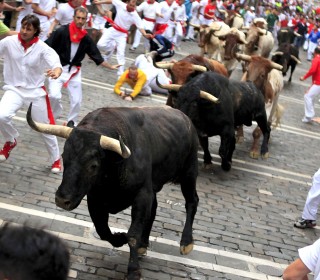“Rough Guides”, the website of a guidebook publishing house with more than thirty years of history, has recently been completely redesigned. Taking a virtual stroll through the new version, we recently came across two sections dedicated to the basque Country, one in Spain and the other in France. The former is given the title “Euskal Herria: The País Vasco and Navarre”, and covers everything south of the Pyrenees, while the “French Basque Country” is lumped into the more generic “The Pyrenees”.
It’s odd how, despite how in both sections the existence of the Basque Country as a single whole is clearly referenced, they didn’t provide a single link to join the two topics, to give readers a better general overview. We think that would be a notable improvement that would help visitors there better understand the Basque reality of being one country split between two states.
But, as you’ve probably guess by the title, not the main reason for this entry. Inside the general information accompanying the Southern Basque Country, we came across a matter that stood our hair on edge. To better prove our point, we quote:
Basque determination for self-rule increased when the Liberals, victors in the Carlist War, abolished the fueros in 1876. The late nineteenth and early twentieth centuries saw the emergence of Basque nationalism as an ideology. The conservative Basque Nationalist Party (PNV) was founded in 1895 by Sabino Arana, the son of a Carlist shipbuilder.
At the start of the Civil War, the Nationalists seized control of predominantly conservative Navarra and Araba, while Bizkaia and Gipuzkoa, dominated by left-leaning industrial cities, supported the Republic. After Navarrese troops captured Irun in 1936 and cut off the northern Republican zone from France, San Sebastián rapidly surrendered. An autonomous Basque government, in practice limited to Bizkaia, lasted just nine months. Franco finally conquered the Basques in June 1937, after a vicious campaign that included the infamous German bombing of Gernika.
What is the conclusion any reader not familiar with Basque history might reach? That the Nationalists, as in the Basque Nationalists named in the first paragraph, were the ones attacking the Republic. It’s beyond words how radically wrong that assumption is. One needs only remember that that the Basque Government that only lasted nine months was led by Lehendakari José Antonio de Aguirre, a Basque Nationalist.
Perhaps these confusions arise from the bad practice among some of not calling a spade a spade. Franco and his goons, who tried to pass themselves off as the saviors of Spain, called themselves Nationals, clearly trying to reinforce the idea that they defended the essence of the Spanish Nation against the Reds, the Separatists, and the Freemasons who wanted to destroy it. They could call themselves however they liked, but it’s sad that others agree that that term is the correct one, because it’s not true. They weren’t Nationals, they were Insurgents, or simply Fascists.

And diametrically opposed to all that was Basque Nationalism, which, as a whole, was on the side of the Republic and Democracy against Fascism. That position was maintained not only throughout the Spanish Civil war, but also during the Second World War, when they collaborated with and fought for the Allies to end authoritarian régimes. It’s a shame that when the latter war ended, the Allies betrayed the Basque Nationalists, allowing the Franco régime to go on. The price Basque Nationalism paid for supporting Democracy was high: death, exile, spoliation, persecution, and violence.
Please, let’s call things by their name. Franco and his followers were a group of delinquents who rose up against the Republic. That way, everyone would understand, and there would be no more confusion.
Rough Guides – Great Britain
Euskal Herria: The País Vasco and Navarra
The name the Basque people give to their own land, Euskal Herria, covers the three Basque provinces that today form the Comunidad Autónoma del País Vasco (in Basque, “Euskadi”) – Gipuzkoa, Bizkaia and Araba – as well as Navarra (Nafarroa) and part of southwestern France. Much of this region is immensely beautiful, and especially so along the coast, where green and thickly forested mountains, interspersed with stark individual hills, seem in places to emerge from the sea itself. Yes, it often rains, and much of the time the countryside is shrouded in a fine mist, but so long as you don’t mind the occasional shower, summer here offers a glorious escape from the unrelenting heat of the south.
(Follow) (Automatic Translation)
———————————–
Rough Guides – Great Britain
The Pyrenees. The Pays Basque
The three Basque provinces – Labourd (Lapurdi), Basse Navarre (Behe Nafarroa) and Soule (Zuberoa) – share with their Spanish neighbours a common language – Euskera – and a strong sense of identity. The language is widely spoken, and Basques refer to their country as Euskal-herri (or, across the border in Spain, Euskadi). You’ll see bilingual French/Euskera toponym signage and posters throughout the region (sometimes only in Euskera), so in this section we have given the Euskera for all locations in brackets after the French.
(Follow) (Automatic translation)
Last Updated on Dec 20, 2020 by About Basque Country





























